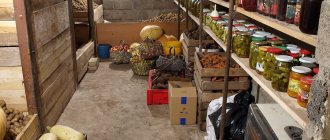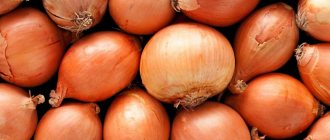Garlic in our country is planted in autumn and spring. Despite the fact that this vegetable is inferior in importance to potatoes and tomatoes, still no housewife can do without this spice.
Dear readers! For you, we have created communities on social networks in which useful articles and interesting ideas are published several times a day! Subscribe and receive useful content in a convenient format!
Storing garlic poses a number of difficulties. Improper conditions lead to drying out or, conversely, rotting of the heads.
In this article we will look at all the possible ways to store garlic at home.
When to harvest garlic?
Harvesting garlic
The harvesting period for winter garlic is in the second half of summer. Specific dates depend directly on the climate of a particular region. For example, in Central Russia, garlic is dug up in mid-July. Spring varieties (that is, planted in spring) are harvested in August, and in more northern regions even in September.
Most often, when harvesting, they focus not on specific numbers, but on the appearance of the bulb. There are several signs that it’s time to dig up garlic:
- Drying and yellowing of the lower leaves;
- Straightening the arrows;
- Ripening of inflorescences (air sacs) on leaves;
- The bulb becomes dense to the touch;
- The cloves come off easily.
For more information about when to harvest garlic, read our article “When to harvest garlic planted before winter.”
How to prepare harvested garlic for long-term storage
The preparation process starts with harvesting the crop. Dig it out carefully, trying not to damage the top layer. If the surface of the plant has “wounds”, it will not last long. Then the crop is thoroughly dried. On inclement days, it is worth spreading it indoors in one layer so that each bulb gets enough air. In bright sunshine, you can place them outside. Drying continues for several days. The stems are then cut off and sorted, removing empty heads, as well as those that have begun to rot. Any damaged bulb should be separated from healthy ones to prevent them from becoming infected. The rejected ones can be recycled, and the good ones can be folded and stored.
How to prepare vegetables for storage
The period during which garlic can be eaten largely depends on how the crop is prepared for storage. Due to improper preparation, there is a high chance that the garlic bulbs will dry out or rot.
Preparation of vegetables for storage begins at the time of harvesting. It is very important to harvest the crop on time to prevent it from over-ripening and to preserve all the beneficial properties of the vegetable.
IMPORTANT! If you are late in harvesting the garlic, the cloves will begin to fall apart. Such garlic cannot be stored for a long time, but it can be eaten as soon as possible after harvesting.
Before storing, garlic bulbs must be cleared of soil, sorted and dried well. Usually the harvested crop is left to dry directly in the garden bed, but if there is a chance of rain, it is better to bring the dug up garlic under a shed or into a barn. Drying lasts about a week. Sometimes it turns out a little less (about 5 days), sometimes a little more (about a week and a half). It depends what the weather is like.
After drying is complete, the garlic is trimmed. The roots are shortened to 3 mm, the tops to 2 cm.
The garlic needs to be dried and the tops trimmed.
REFERENCE. If garlic is supposed to be stored in braided braids, then the tops are not cut off.
How to keep garlic from drying out when storing in winter
If stored for a relatively long time and the storage rules are not followed, the harvested garlic can suffer from such a problem as drying out - the evaporation of all or most of the moisture from the cloves. Why can garlic dry out during storage? Due to improper organization of storage space and untimely harvesting. First of all, it is necessary to organize storage so that not a single technological condition is violated. The paraffin already described above helps. It promotes the accumulation of carbon dioxide in the vegetable from plant respiration, which is the best prevention of diseases.
Also, vegetable oil poured into jars with garlic cloves will help prevent drying, after which they need to be placed in the refrigerator or basement (if available). Table salt is another way to prevent the garlic crop from drying out; it should also be poured into jars with cloves and tightly closed with lids.
Table salt helps preserve garlic
What storage conditions must be observed?
Garlic keeps relatively well under almost any conditions. But, if you want to preserve the quality of vegetables for a longer period of time, you need to adhere to the following rules.
- Dark place. This could be a cardboard box, a jar under a table, a refrigerator, or an attic. It is very important to protect garlic from sunlight in winter.
- Humidity 60 – 80%. If the air is too dry, the garlic will dry out quickly, and if there is too much moisture, it will begin to rot. If in winter you begin to notice that the garlic is not as juicy as before, it means that the air in the room is too dry.
- Cool. The optimal storage temperature for spring garlic is 18 degrees, winter garlic is 5 degrees. If you live in your own home, you can place garlic in the attic or basement. But, if you live in an apartment, it will be difficult to ensure the desired temperature. Of course, vegetables can be bagged and placed in the bottom drawers of the refrigerator. But what if they all don’t fit there? In this case, try storing the vegetable canned. We will tell you more about this method below.
- Air access. Garlic is best stored in parts in different small containers. Storage in an open space can cause early drying out of the heads.
Garlic should be stored in a dry, cool, dark place.
IMPORTANT! If mold appears, the affected specimens should be thrown away. The remaining ones should be carefully examined and moved to a room with drier air.
Optimal conditions for long-term storage of garlic
When storing at home, it is important to create a favorable microclimate. Environmental conditions directly affect the maximum shelf life of the harvested crop, its taste characteristics and marketable appearance.
Humidity
The suitable humidity level varies widely - from 50 to 80%. Higher humidity can cause the crop to rot, and a low humidity level causes the cloves to dry out.
Temperature
Garlic is considered unpretentious to the ambient temperature, so it can be stored both warm and cold. However, there are small restrictions:
- When leaving the crop warm, it is recommended to ensure the temperature is within 15-20 degrees. It is better to store spring varieties at this temperature.
- When in the cold, the optimal temperature is 2-4 degrees. This regime is favorable for winter species.
It is also important to avoid sudden changes in temperature. Changing conditions negatively affects taste.
Ventilation
The room in which winter supplies are left should be periodically ventilated. Fresh air flow prevents the development of mold and harmful microorganisms. It is also recommended to make small holes in storage containers for constant air circulation.
Light
Semi-dark places are ideal for storing crops. It is necessary to limit direct sunlight on the fruits so that they remain fresh and rich in taste for a long period.
See also
How and for how long you can store shelled walnuts at home
Why does garlic rot?
There are several reasons why garlic rots.
Most often this happens because a poorly dried vegetable was stored. The second most common reason is lack of air circulation. The garlic simply “suffocates.”
Improper conditions also lead to the onset of putrefactive processes. Storage in an overly humid room at elevated temperatures will most likely lead to rotting of the garlic.
We must not forget about such a reason as diseased specimens. Just 2-3 garlic cloves infected with fungus are enough for the entire crop to rot.
How and where to store garlic
There are many ways to preserve garlic during the cold season. Each of them, if you follow the rules, will allow you to preserve your garlic harvest for several months. Which method is more suitable must be decided based on the harvested crop and the free space in the room.
Storage in a basement or cellar
This method is advantageous because the temperature in the basement is ideal for storing winter varieties of garlic. Plus, garlic can be stored there away from sunlight. For packaging, you can use almost any container: boxes, boxes, jars, bags or nets.
An important point: the basement should not be too damp, otherwise the garlic will simply rot. If the humidity is slightly more than 80%, then add sawdust or flour to the boxes.
Storage in wooden boxes
Garlic bulbs are stored unpeeled in wicker baskets, wooden or plywood boxes. This is one of the most common and accessible methods, but it is associated with the greatest amount of losses due to drying or rotting of vegetables.
Most often, garlic heads are stored in baskets, boxes and drawers when there are a lot of them and processing, for example, for storage in crushed form or in a marinade, will take a very long time.
How to save in banks
Garlic heads are stored in ordinary glass jars:
- In the form of cloves;
- In the form of heads.
In the first method, the onion is disassembled into cloves, each of which is inspected, further dried and placed in a jar. In this case, the husk is not removed directly from the slices.
The advantage of this method is that there will be less husk in the jar, and you can always take as many cloves as you need. The disadvantage is that disassembling each head into slices will take a certain amount of time.
IMPORTANT! Each jar must first be rinsed and dried. There is no need to roll up the jars. Simply cover them with a metal lid.
How to store in fabric bags or mesh
Storing garlic heads in a net is one of the most popular ways. Firstly , this ensures air access. Secondly , the nets can be hung on hooks. Thirdly , string bags are easy to get. Fourth , the heads are easy to inspect during the winter for drying out or rotting.
If you have fabric bags, you can soak them in saline solution, dry them and put garlic in them. Salt will perfectly protect the vegetable.
In a braided braid
One of the oldest, most beautiful and most labor-intensive methods.
To store garlic in braids, you cannot cut off the tops.
The braid is woven in the usual way, from the heads to the tips of the leaves. My only advice is not to add a lot of garlic at once. It is best if there are no more than 15 heads in one braid. The finished bundle is hung on the wall or ceiling. By the way, you can decorate the interior of your kitchen with such a scythe even in a city apartment.
In paraffin
Paraffin allows you to keep the heads intact until the beginning of summer. This is a very effective method, although somewhat labor-intensive.
- Sort the garlic heads.
- Cut paraffin candles and melt them until smooth in a water bath.
- Burn the bottom of the head with a lighter, match or on a gas burner.
- Take the garlic bulb by the tip of the stem and immerse it in liquid paraffin for 2-3 seconds.
- Place the head on the newspaper. Paraffin hardens very quickly.
- Cool all processed vegetables and transfer them to a jar or box.
Paraffin covers the garlic head with a thin, impenetrable film and protects the vegetable from both atmospheric influences and pests.
In the sawdust
Sawdust protects garlic from excessive air humidity. The heads and wood chips are poured into boxes, baskets and boxes in layers. The last layer of sawdust, which should completely cover the vegetable.
Dried
In addition to the usual methods, you can store garlic in dried form. To do this, the cloves must first be dried using a conventional oven or electric dryer. Then they are cut into slices and laid out on a baking sheet, after which they go into the oven for 30-40 minutes. Drying temperature is about 60 degrees.
Then let the dried slices cool and place them in jars or bags. Such slices can immediately be used in cooking.
Dried garlic can be stored for about 1.5 – 2 years.
Harvesting garlic, preparing for storage
Garlic is a rare crop in which everything is edible: leaves, fruits, shoots, flowers. Parts of the herbaceous plant are rich in essential oils, allicin, phosphorus, and selenium. Phytoncides are of particular value. Thioesters give the plant its aroma, and minerals give it a unique pungent taste.
Garlic belongs to the Allium subfamily. In Russia it is planted twice a year: in autumn (winter) and in spring (spring).
Ripens depending on the region. In the south of the country, winter crops are ready in early July, in the north - in the middle or by the end of July. Spring varieties ripen 3-4 weeks later.
Garlic
Ripeness is determined by the dryness of the stems. Half dry - time to harvest. Withered leaves are not capable of photosynthesis, fruits can no longer swell and grow. They collected all the necessary nutrients.
The tops are not allowed to dry out and lie down. When the stem turns yellow to the base, the husk cracks, the cloves separate, and lose their taste and medicinal qualities.
Attention! Preparation for storage begins already at the ripening stage. A month before harvesting, stop watering so that in the future excess water in the fruits does not provoke rot.
A week before harvesting, the heads are slightly freed from the soil. Take the stem and lift the bulbs up. It is necessary to undermine the root system, but not to overdo it, so that the heads do not end up in the sun - they will bake. If such a risk arises, the plants are covered with straw and mown grass.
Dig with a shovel or pitchfork and shake off the soil. However, you cannot immediately cut off the tops.
Garlic harvest
For final ripening and better storage, garlic is laid out to dry in the sun or under a canopy in the breeze. At this time, the bulbs “pick up” vitamins and minerals.
After 2-3 weeks, the stems are cut off 4-5 cm from the bulb, peeled from the top layer of husk, and the roots are cut off. They inspect the harvest to see if there are rotten fruits, mold or mildew. Sick tubers are discarded.
Next comes concern for the safety of the harvest.
How to store garlic in an apartment
Storing vegetables in an ordinary city apartment is somewhat more difficult due to the fact that the space in it is limited. This greatly limits the use of wooden boxes, sawdust and the braiding method. But there are several other ways that will help you preserve vegetables throughout the winter and will not spoil the appearance of your apartment.
On the loggia
You can store garlic on a loggia or balcony if it is closed. And it’s even better if it’s insulated. Then in winter there will be no moisture there, but it will be quite cool. And these are ideal parameters for storing garlic.
But even in this case, the heads must be sorted regularly in order to notice rotten ones in time and not lose the entire harvest.
In a refrigerator
Garlic can be stored in the bottom drawer of the refrigerator
. The refrigerator is the best place to store garlic directly in the apartment itself. The vegetables are folded into bags and placed in the bottom drawer. The disadvantage is limited space. But, if there are only a few garlic heads, then the refrigerator is the best choice.
Shredded or twisted
If your garlic begins to deteriorate, then it needs to be chopped. To do this, use a blender, meat grinder, or simply cut it with a knife.
IMPORTANT! Rotten or dried cloves should be thrown away, good ones should be cleared of scales.
Add a little salt to the resulting mass, mix thoroughly and place in jars with tight-fitting or screw-on lids. After this, put the jars in the refrigerator.
This method will preserve the garlic for some time.
How to preserve in oil
Storing garlic in oil
Storing garlic in oil is a rather interesting way. You need to separate the cloves from the head and clean each of them. Then sort out the best ones, rinse them with running water and dry them with a towel.
Next, you will need a sterilized jar with a screw-on lid. Place the cloves tightly there and pour in vegetable oil so that it covers the garlic. Close the jar with a lid and place it in the refrigerator.
In this form, the vegetable can be stored for about 2.5 - 3 months. By the way, vegetable oil can then be used in cooking. It will absorb the garlic aroma and give dishes a piquant taste.
How to store in a jar with salt or flour
Approximately 4 cm of table salt or flour is poured into the bottom of the jar. Then place the peeled garlic cloves in circles or rows so that there is at least 1 cm of bulk product between them. Then add salt (flour) again to hide the garlic. The thickness of the last layer should be approximately equal to the thickness of the first.
The advantage of this method is that the garlic is not subject to drying out or rotting. The disadvantage is that it is not very convenient to look for individual cloves in flour and salt.
Frozen storage
You can freeze garlic whole, in slices or ground.
The third option is most often used. To do this, the vegetable is first ground, mixed with a small amount of salt and placed in plastic containers or cellular bags for making ice.
IMPORTANT! Garlic cannot be re-frozen. Take this fact into account when packing it before freezing.
Storing chopped garlic in the freezer
Frozen garlic is stored for about 6 - 9 months, after which it begins to lose its taste.
Canned
Few people know, but garlic can be preserved in the same way as cucumbers or tomatoes. You will need:
- 1 kg of garlic cloves;
- 100 g salt;
- 100 g sugar;
- 1 glass of vinegar.
Preparation:
- The cloves must first be cleaned and washed. Sterilize jars and lids.
- Boil the slices in water over low heat for 5 minutes.
- Mix sugar, salt and 0.6 liters of water.
- Boil the mixture and add vinegar.
- Take jars and put garlic cloves in them.
- Pour the marinade into the jars and roll up the lids.
In onion skins
Onion peels are good because they prevent the vegetable from rotting and also protect the crop from rotting.
For this storage method, you need to pour onion peels into a box or box with holes and “bury” the garlic heads in it.
In this way, garlic can be stored for up to 6 months.
In wine (wine vinegar)
It's no secret that storing garlic in an apartment is very difficult. The vegetable often begins to rot or, conversely, dry out.
One of the unusual ways is to store it in wine or wine vinegar.
Everything is very simple. Peel the cloves, put them in a jar, fill them with wine, add bay leaves and spices for taste.
This garlic is great for preparing culinary delights.
Storage methods
People have used many methods when storing at home. The main thing is protection from heat, light and humidity. You can store garlic for a long time in a cellar, basement, pantry, or glassed-in balcony. It is stored in dry, dark places, for example, in a sofa, closet, nightstand. Some people prefer to store garlic in braids (tie several heads by the arrows into one braid and hang them in the cellar) or in glass jars in bulk substances (salt, flour, ash, sawdust) that can absorb excess liquid, in cardboard boxes and wooden boxes.
Garlic should not be stored in a plastic bag or wrapped in cling film. Without air access it will become damp and moldy.
To prevent garlic from germinating, its roots must be cut and burned with a blowtorch or gas torch before storage.
Let's consider information on how to store garlic at home, and which methods are more reliable.
In banks
One of the simplest methods for storing garlic is storing it in jars. Everyone has them, and you don’t have to look for a special place to store your harvest, because the jars can be placed in a regular cupboard. Glass containers will not allow bacteria and fungi to spoil the product. Organizing such vegetable storage is not difficult. You need to place the heads of garlic in a clean and dry container to the top and close with a lid. Instead of a lid, you can use a piece of gauze or cotton cloth.
You can store garlic divided into cloves without removing the scales. This method will allow more cloves to fit into the jar. But there is one advantage to this: when dividing the garlic into cloves, you can check if there are any damaged parts in the head that could spoil the remaining whole pieces.
The jar can be filled with auxiliary substances, for example, flour, salt, rice, sawdust. The main condition is clean and dry containers. Some people prefer to store garlic in a vacuum, in oil or even in wine. Storing garlic in an apartment is a common thing, but there are a few tricks. We invite you to find out.
In flour
If you use flour as a filler for storing garlic, it will prevent it from compacting and becoming damp. To do this, you need to pour dry flour into the bottom of a glass jar (2 or 3 liters) in a layer of about 2-3 cm. Then you need to put several heads there, roots down, as when planting, and sprinkle with flour again. This should be repeated until the jar is full.
The heads must not touch each other.
The jar is closed with a nylon lid to avoid the appearance of pests. You can store garlic in flour even in disassembled form, but there is no need to peel the cloves from the protective film, then it will better retain its beneficial properties.
In salt
Like flour, salt is an excellent insulating agent for storing garlic. In addition, it also disinfects. Therefore, the likelihood that mold will appear in garlic when stored in salt is very low.
To store garlic for the winter, you need to take any salt except iodized salt. Stone is good for this. Just like with flour, you need to sprinkle the garlic (whole heads or cloves) with salt, starting with a layer of salt. The last layer should also be made of salt. You don't have to cover the jar with a lid. Salt, unlike flour, cannot harbor bugs, and it also has good hygroscopicity. In it, garlic retains maximum benefits.
In paraffin
Paraffin is an excellent means for storing garlic, because it helps preserve the harvest until the new season. To preserve garlic until spring, you will need paraffin candles (purchase at a hardware store), two saucepans, water and newspaper. Candles need to be cut into pieces, placed in a saucepan and melted in a water bath. To do this, you need to put water in a pan of a larger volume than the pan with candles, boil the water, switch to low heat and place the pan with candles in it. Stirring thoroughly, you need to wait until the candles melt into a homogeneous thick mass. Then you will need to take a head of garlic by the stem, lightly burn its roots with a lighter or over a gas stove, and then dip it in the paraffin mass. After this, transfer the head to newspaper or parchment. Paraffin hardens quickly, forming a reliable protective film on the head that is moisture and airtight. This protects it from drying out and rotting. This should be done with all the garlic. The heads treated in this way can be placed in a cardboard box or glass container and stored in a closet or pantry. Garlic will remain fresh, juicy and healthy for a long time.
In the refrigerator or cellar
Both the refrigerator and the cellar provide optimal conditions for storing garlic. There is low temperature and humidity and virtually no light. Storing garlic in the refrigerator is especially convenient for city residents. Dry the garlic and place it in paper bags. It should be stored separately from other vegetables. Do not store garlic in the refrigerator in a bag. Without access to air, it will begin to dampen and soon become moldy.
Some people store garlic in the freezer, but this way it loses its beneficial properties.
Many people choose to store garlic in braids in the cellar. This is a reliable way. Sometimes garlic is sold in braids.
In oil
One popular method is to store garlic in oil. This method allows you not only to preserve garlic, but also to obtain aromatic and tasty oil. This oil can be used in the future for preparing salads, appetizers and main courses. And to enhance the aroma of the oil, you can use ground or allspice, Provençal herbs, salt, and bay leaf during storage.
In order to preserve garlic in oil, you must first disassemble it into cloves and peel it. Then the cleaned cloves need to be placed in a pre-sterilized jar and filled with vegetable oil to the top. Oil can be olive, sunflower, flaxseed or pumpkin. You need to ensure that the oil completely fills the jar and surrounds all the cloves without forming voids. You can store garlic in this form in the refrigerator or cupboard.
It is important that there are no heating or any other heating devices nearby.
Purified
When peeled, garlic is stored worse, but it is stored this way if they want to save space. Then you will additionally need to take into account the fact that without husks, garlic loses moisture faster and wrinkles. It is better to keep it in the refrigerator or in a jar with oil or bulk products.
Grinded in a meat grinder
In order not to peel the garlic every time you need it when cooking, you can first peel and chop it using a meat grinder. It is better to add a little vegetable oil to the garlic mass and mix thoroughly. The resulting paste should be lightly salted, transferred to a sterilized glass jar, closed with a lid and put in the refrigerator. This method is especially helpful when the garlic stored for the winter suddenly begins to deteriorate. Twisted garlic can be stored for 3 to 4 months.
In fabric
You can store garlic in canvas bags or cotton cloth. This method is good because there is no disruption of air circulation and the creation of a greenhouse effect. To do this, the garlic does not need to be peeled and disassembled into cloves. The storage location must be protected from sunlight, heat and high humidity.
In the sawdust
The principle of storing garlic in sawdust is not much different from storing it in salt or flour. To do this, you need to take a cardboard or plywood box and add sawdust to the bottom. The first and last layers should be sawdust and completely cover the garlic. Garlic will last longer if the sawdust is from coniferous trees.
In ground form
Garlic can also be stored in ground form. To do this, you must first cut it into thin slices and dry it in an oven or electric dryer at a temperature of 50 degrees. After the moisture has completely evaporated from the garlic and it has hardened and become slightly yellower, it needs to be ground in a blender or coffee grinder. The dried and ground vegetable is poured into a clean, dry glass or tin container. Store this seasoning in a regular kitchen cabinet.
How to store peeled garlic?
Peeled garlic
You can store peeled garlic as follows:
- in the refrigerator (freezer);
- in pickled form (brine or vegetable oil);
- in flour or salt.
Whatever method you choose, you need to adhere to a number of rules. They are simple, but will allow you to preserve the vegetable for a longer time.
- Select only healthy, cleaned and dried cloves for storage.
- Inspect regularly.
- Do not refreeze.
What problems may arise during storage and how to solve them, table
Storing vegetables in winter is a long process, during which various difficulties inevitably arise.
We have collected them in a table and also listed ways in which the problems that have arisen can be solved.
| Problem | Cause | Solution |
| Garlic dries | Excessively dry and hot room | Provide the required level of temperature and humidity. Wrap the heads in cling film. If it is impossible to create the necessary conditions, choose another storage method (in paraffin, crushed, etc.) |
| The garlic is rotting | The vegetable is stored at high humidity and temperature. There is no air circulation. The heads are poorly dried when stored. Garlic plants are contaminated. | Provide the required level of temperature and air humidity. Make ventilation holes in the container. Throw away rotten specimens. |
| Garlic bulb sprouts | The crop is stored in conditions of high humidity and temperature | Provide the required level of temperature and air humidity. Burn the bottom over the fire. Use sprouted cloves for cooking. |
| The teeth turn yellow | The cloves are infected with fungus | Throw away the sore heads |
Selecting a location
Methods for storing garlic at home depend primarily on the right location. It is advisable to consider several points:
- variety and time of harvest, since winter and spring plants require different temperature conditions;
- degree of illumination - it is advisable to choose a dark room;
- humidity level - at high humidity, the onset of rotting and the appearance of fungus is almost guaranteed.
Tips on how to store young garlic in an apartment and private house will help you choose a suitable place.
| Storage | Peculiarities |
| In the basement | Based on the degree of combination of temperature, humidity and degree of lighting, the basement (cellar) is considered the best option for storing fresh vegetables and fruits in the winter. To prevent plants from being affected by fungus, ventilation must be provided in the basement. In the summer, the premises must be cleaned, disinfected, garbage swept out, old empty boxes, jars, and canned goods taken out. Walls and floors are treated with a solution of copper sulfate and whitened. |
| Pantry | A dry and dark pantry room with a temperature from +18 °C to +25 °C is also an option where to store dug garlic in winter. Bulbs do not germinate in the dark, but with minimal humidity it is important to choose the right storage method. For example, you can hang them in ventilated nets, collect them in bags, braid them and hang them in braids. It is desirable that the crop receives a sufficient amount of fresh air. |
| In a city apartment | In the absence of a cold, dark place, the ripened heads can be placed directly in the kitchen. Housewives choose several forms of storage:
|
| On the balcony | In the autumn-winter period, you can leave garlic only on an insulated balcony or loggia. Sudden temperature changes on an open balcony will ruin the harvest and the slices will freeze. There are options for storing garlic in glass jars or in boxes with sawdust. |
On a note. If the plants still have strong tops after harvesting, it is recommended to weave a braid of garlic and decorate it with decorative flowers. The braids are hung in the kitchen away from the stove and water and used as needed, cutting off the heads from the braids. Such natural decor decorates the interior, allowing you to easily get the right amount of aromatic spices.
Common mistakes
- The garlic is not dried well. Because of this, most of the problems associated with storing garlic arise.
- Storage conditions are not met. This is a whole group of errors. Storage in unventilated boxes, storage in too humid or, conversely, too dry areas.
- The bottom is cut too much. The bottom at the head must be cauterized. If you trim too much, such a wound will certainly become a source of infection and disease.
- Diseased heads are not thrown away. If you find diseased and rotten bulbs, they should be thrown out immediately, and the neighboring ones should simply be removed from the common box and carefully examined. Leaving diseased garlic plants means putting the rest of the harvest at risk.
Answers to frequently asked questions
How can you tell if garlic has started to spoil?
Firstly, an unpleasant odor appears, the teeth darken, and spots appear. And then the garlic becomes "empty"
What to do if the garlic starts to spoil?
Those garlic plants that show strong signs are thrown away. If signs of spoilage have just begun to appear, the diseased cloves are thrown away, and the rest are processed for cooking.
What to do with sprouted garlic?
This garlic is processed for consumption.
What is the best storage method for an apartment?
It all depends on how long you are going to store the vegetable and how many garlic cloves you have in total. If the harvest is small and you process it quickly, you can store it in a box in the kitchen.
Otherwise, you should be concerned about creating suitable conditions. If this is not possible, then store the garlic in paraffin, oil or chopped.
Garlic storage options
You can store garlic in almost any conditions: both a private country house and a modern city apartment are suitable for this. We'll tell you how to keep garlic fresh and processed.
Fresh storage
Garlic is best stored in basements and cellars, where the conditions are most suitable. In these rooms, the container in which the harvest is stored is of great importance. Suitable for garlic:
- unnecessary stockings or tights;
- mesh bags;
- cardboard boxes.
It is believed that placing bulbs in nylon products allows you to fully preserve the harvest. There is good air circulation here and no excess humidity is created. Mesh bags are also suitable for our purposes, but there will be garbage underneath them, and they also need to be hung, which not everyone can do, or placed on wooden pallets.
If you have free time, you can weave garlic into braids and hang them on the wall.
It is undesirable to have a clutter in the apartment, so you will have to use a little trick - transfer the garlic into jars. To do this, they are thoroughly washed, dried on the windowsill, and wiped. Garlic is separated into cloves so that the scales remain intact. A layer of salt, flour or stove ash is poured onto the bottom of the jar, then a layer of garlic is placed and this is repeated until the container is filled. Salt in this method plays the role of a desiccant. Filled jars are covered with paper napkins and stored in a dark, dry place. In this case, garlic can be stored for up to six months without loss of quality.
You can package the garlic in fabric bags, but they need to be pre-treated. To do this, make a concentrated saline solution (200 g of salt per 500 ml of water), then soak the bags in the resulting concentrate for an hour. The final stage is drying in the sun. As a result, the fibers will be saturated with salt, which will act as a barrier to bacteria and fungi. Garlic can be stored in this casing for 5 months, provided that the bags are kept in a place protected from high humidity.
The last method is to pour paraffin over the garlic. This substance, when cold, protects the bulbs from high humidity and does not allow bacteria to pass through. Garlic is processed in the following sequence:
- Take paraffin candles, grate them on a coarse grater and keep them in a water bath until melted.
- Garlic is taken by the “tail” and dipped into melted paraffin so that the entire surface of the bulb is covered with the substance.
- The paraffin is allowed to harden and then placed in boxes of a suitable size.
In this form, garlic can be stored for up to six months. You can extend the shelf life if you use beeswax instead of paraffin, but the cost of preservation will increase significantly. You can also wrap the bulbs in cling film, the effect will be similar.
The methods listed above allow you to preserve garlic without deteriorating its taste for up to six months, but there are other, more effective methods.











